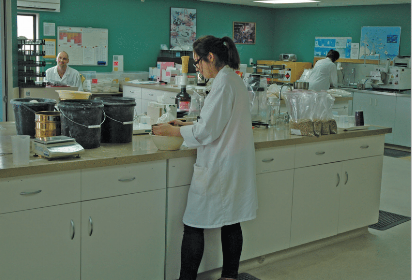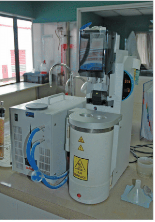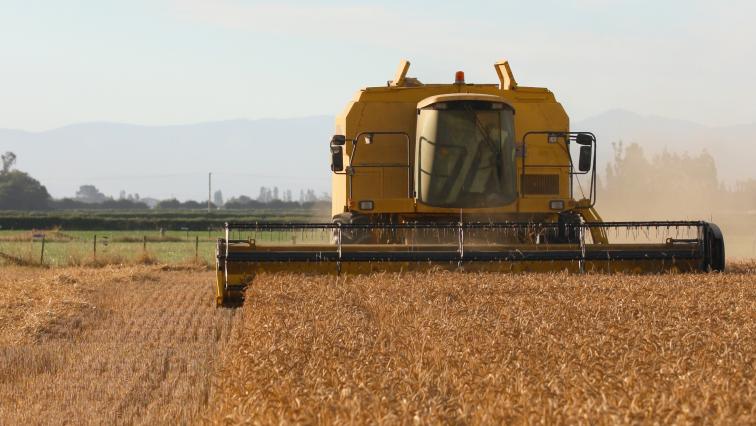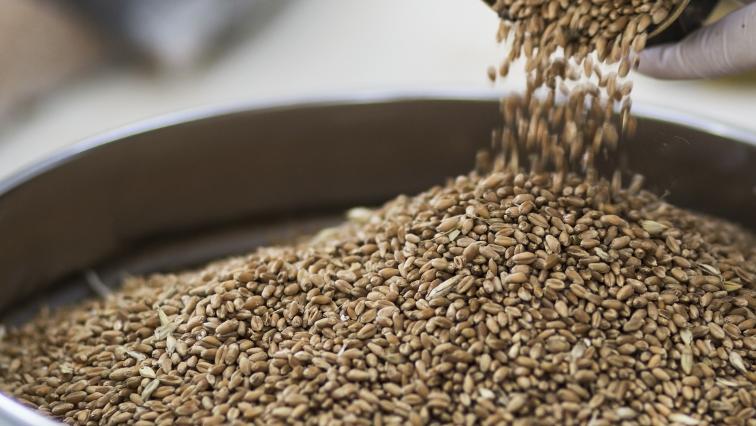There are a number of ways to determine the quality of flour produced and its use. These quality indicators can be split into three broad categories when determining the quality of flour produced:
- Sensory properties
- Their components
- Testing
The page below gives more detail about these quality indicators.

A very simple way to determine colour differences in batches of flour is to look at the colour of different types of flour under a sheet of glass. This can be done with more than one flour at a time. This method allows for a comparison of the whiteness of different flours but also an inspection for impurities. For white flour it should be of "perfectly regular consistency and not contain any specks”. Several methods exist for the measurement of colour, all of which relate to the quantity of reflected or absorbed light.
The texture and size of granulation plays an important role in kneading and also determines the speed at which the dough rises. In general, bread flour is slightly coarse and falls apart when pressed into a lump. Pastry flour is smooth, fine and can be squeezed into a lump. The same characteristics apply for Cake flour although in addition it stays in a lump more solidly when pressed.

The level of moisture in flour is important in terms of shelf life. The moisture of flour will be 14-15%, which when stored in appropriate conditions (relatively cool, dry and aerated) allows for plenty of shelf life. If the moisture level exceeds 16 % the shelf life of the flour is greatly reduced.
The absorption ability measures the amount of water that can be absorbed by a given quantity of flour. In bread making, it is usually preferable to have flour that can absorb a large amount of water. Measurements of absorption are done to determine the amount of water the dough can absorb, which in turn indicates dough yield and shelf life. Optimum absorption represents the maximum amount of water, as a percent of the flour weight that will produce a high yield of bread during the baking process.
Traditionally flour protein has been the main parameter used to judge flour quality and strength. Today we know that not all wheat protein is created alike.
Wheat "protein" or Albumen is composed of four types of protein: gliadin, glutenin, albumin and globulin. Gliadin and glutenin comprise roughly 85% of the Albumen and are the gluten-forming components. Albumin and globulin are water soluble meaning they don’t add to the strength of the flour. The percentage of protein (Albumen) only tells us the amount of protein but this figure does not tell us anything about the type, or quality of protein. The farinograph test gives us more valuable information about the “quality” of the protein and ultimately how it will perform in the bakery.
The ash content of the flour is determined by burning a sample of flour. The minerals naturally present in the flour do not burn and remain as ash. The weight of the ash is then compared to the original sample. The ash content indicates the extraction rate of the flour. A higher ash content indicates higher extraction. Most flours will have an ash content below 0.6%.

The falling number test determines the amylase activity of a flour sample. The amylase enzymes are used to break down the starch in flour to release sugar ready for fermentation.
The test involves heating measured amounts of water and flour in a special test tube. The tube is placed in a boiling water bath and agitated with a plunger for 55 seconds to allow the sample to gelatinise. Then the plunger is released at the top of its cycle on the surface of the sample, the time that it takes the plunger to sink through the gelatinised starch to the bottom of the tube is recorded. The total time in seconds (including the original 55 seconds) is recorded as the "falling number". The minimum result number is 55 and some flours can push into the high 400's and beyond.
Depending on the alpha-amylase activity, the degradation of the starch paste will vary. The higher the alpha-amylase activity, the lower the number, and vice versa. In Australian and Canadian wheats, typically the falling number has to be adjusted (reduced) in the flour through the addition of diastatic malt, or fungal amylase for use in the Bakery. Generally, the baker will find that fermentation progresses more rapidly as falling numbers become lower.


